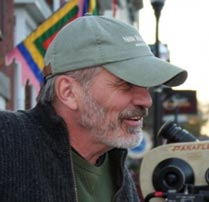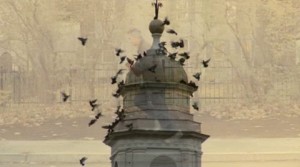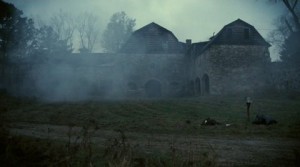Part 11, From shoot to wrap
 And so the shoot progressed…
And so the shoot progressed…
One of my favorite shots in the film–a shot that comes late in the movie at the highpoint of the story–is of the classic New England clock tower on top of the Unitarian Church in the middle of Peterborough. We were lucky enough (I’m noticing I’m using that word “lucky” a lot) to have our second unit catch a huge flock of pigeons nestled on the tower one afternoon.
After setting up camera, one of the crew slammed two pieces of 2×4 boards together with a load whack. And suddenly all the birds took off together in a burst of energy and fluttering wings, made a wide circle around the tower against a pinkish sky, and then settled back down again exactly as they were before.

It’s a beautiful shot and in a sense captures the moment with David Strathairn’s character Finn near the end of the film (in the shot above it’s a dissolve from the tower into Finn running, a la “It’s a Wonderful Life” ).
High on the list of enjoyable times during the shoot was all of us gathering at the end of each day’s filming at our production office on Grove Street–the top floor of an old refurbished office building–and watching the dailies, the developed footage shot the day before. Every evening a production assistant had to drive our exposed 35mm film to Logan airport in Boston, where it was flown to New York City for developing, and then return it to us the next day for viewing. Hence the term “dailies.” For those unfamiliar with 35mm film shoots, this procedure is necessary in order to see if what we shot was what we wanted and if it wasn’t, immediate reshooting had to be scheduled while those particular actors were still in town.
Fortunately, we never were unhappy with our dailies. Instead, it was a sweet nightly reward for us to all sit around Aaron’s office (often with a bottle of wine) and watch the takes–pieces of our film in the making. We soon realized that we just might have something very special, and without fail this helped bolster us for the next day’s work. In fact, there was a growing excitement throughout the shoot as it became clearer every night that our story was indeed being captured beautifully on film.
Also memorable was one exceptionally cold day when we were shooting the climactic scene inside a large and mysterious old barn that also appears in the first scene of the film…

Everyone was stomping their feet and blowing on chilled hands to keep warm when suddenly a truck pulled up and big vats of soup were unloaded: an unexpected and unheralded gift from our star, David Strathairn (who’s so modest in real life that he probably would wish I hadn’t told this story).
Throughout our three weeks in Peterborough, the cooperation of everyone in town was astonishing. It was as if the people there and all of us working on the movie were on the same team. Every day crowds gathered around the scenes being shot, politely watched us work for awhile and then proceeded to go about their business as if we were just a normal part of the town’s activity. I loved that. When we had to stop traffic for a shot, no one gave us a hard time. When we had to block off a good portion of the downtown parking area for our many trucks and mobile homes, people seemed to shoulder this inconvenience with a smile–at least we didn’t hear any complaining. Restaurants gave us discounts and welcomed us with open arms.
The whole shoot was one big adventure for us and the town. Peterborough became our backlot at Universal. Our authentic living and breathing movie set. And I’m happy to report that in addition to the fun we all had, we were able to give back to the community several hundred thousand dollars in trade during our stay. A small payback, but not insignificant–one of the main reasons why Van McLeod, New Hampshire’s Commissioner of Cultural Resources, along with the State Film and Television Office are working so hard to bring other feature films to the state (especially indies)–it can be a potentially huge boost to our economy.
For a glimpse of our last day of the shoot, check out the Making Of Documentary page, Clip 5 on the website. It says it best.
At the end of the shoot we had our wrap party at the Cafe at Noone Falls, paid for by several generous sponsors and the State Film Office. It was a joyous occasion, even if all of us were more than exhausted. The important thing was that we had the entire film in the can–133,000 feet of it to be exact, and we knew we had captured great performances by every actor and had caught the town of Peterborough at the peek of fall splendor. We were very tired but very grateful filmmakers.
(Next: Enter phase four–post production...)













I’m surprised no one else commented yet on this one. I don’t remember the pigeons on the tower shot… I have to go watch the movie again. Was just thinking today about watching it again…. What I find great about the film is that it feels more like a play in a cinematic form. Depth, layers, and gives you the ability to actually think about what you’re watching. Plus it was nice to see a film without NY or LA or some other large city as the backdrop. So many films make small-town USA almost seem non-existent. Yours captured the feel of that without pushing it.
Thanks for the good words about our film. It’s interesting and encouraging that as the word of mouth continues to build for the movie we’re discovering there’s a big audience out there that enjoys films that, as you say “give you the ability to actually think about what you’re watching.” Those have always been the kind of films I enjoy the most and the kinds of films we’re committed to producing.
Here’s a good question that I think many, many filmmakers and aspiring filmmakers would have. Since you were the producer on Sensation and have seen both the good and the bad situations with producing an independent film, what would be your top 3 pieces of advice that you would give to anyone who is trying to produce an indie film?
Interesting question, John. Let’s see…my top 3 pieces of advice to anyone trying to produce an indie film: 1) start with a smaller project in terms of budget, meaning giving real consideration as to seriously limiting locations, cast size, the need for special effects, or any other elements that will cost a fortune; 2) make sure the script is absolutely as good as it can possibly be before moving into pre production–this one is key and the biggest and most common mistake made in the indie world; and 3) start thinking about how you’re going to market your film when you’re still in the planning stages of the project–work out a strategy (a plan A and a plan B) for distribution, alternative or otherwise, so that the film you end up making and finishing has a road to follow into the marketplace and a good chance of connecting with its audience (because more than likely you, the indie filmmaker, are the one that’s going to make that happen).
Thanks. Great advice.